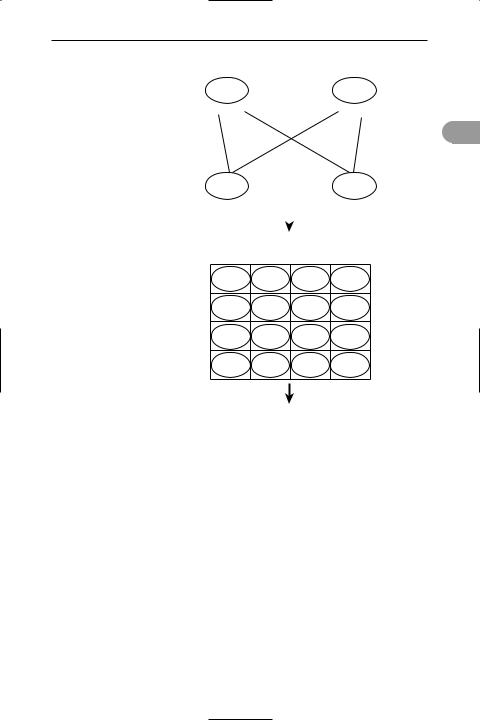
A Dictionary of Science
.pdf
diakinesis |
236 |
(2)both form crystalline nitrides that are hydrolysed in water;
(3)addition of hydroxide ion to solutions of the salts gives an amphoteric hydroxide, which is soluble in excess hydroxide giving beryllate or aluminate ions [Be(OH)4]2– and [Al(OH)4]–;
d(4) both form covalent halides and covalent alkyl compounds that display bridging structures;
(5)both metals dissolve in alkalis. Boron and silicon:
(1)both display semiconductor properties;
(2)both form hydrides that are unstable in air and chlorides that hydrolyse in moist air;
(3)both form acidic oxides with covalent crystal structures, which are readily incorporated along with other oxides into a wide range of glassy materials.
The reason for this relationship is a combination of the trends to increase size down a group and to decrease size along a period, and a similar, but reversed, effect in electronegativity, i.e. decrease down a group and increase along a period.
diakinesis The period at the end of the Ürst prophase of *meiosis when the separation of *homologous chromosomes is almost complete and *crossing over has occurred.
dialysis A method by which large molecules (such as starch or protein) and small molecules (such as glucose or amino acids) in solution may be separated by selective diffusion through a semipermeable membrane. For example, if a mixed solution of starch and glucose is placed in a closed container made of a semipermeable substance (such as Cellophane), which is then immersed in a beaker of water, the smaller glucose molecules will pass through the membrane into the water while the starch molecules remain behind. The plasma membranes of living organisms are semipermeable, and dialysis takes place naturally in the kidneys for the excretion of nitrogenous waste. An artiÜcial kidney (dialyser) utilizes the principle of dialysis by taking over the functions of diseased kidneys.
diamagnetism See magnetism.
1,6-diaminohexane (hexamethylenediamine) A solid colourless amine,
H2N(CH2)6NH2; m.p. 41°C; b.p. 204°C. It is made by oxidizing cyclohexane to hexanedioic acid, reacting this with ammonia to give the ammonium salt, and dehydrating the salt to give hexanedionitrile (NC(CH2)6CN). This is reduced with hydrogen to the diamine. The compound is used, with hexanedioic acid, for producing *nylon 6,6.
diamond The hardest known mineral (with a hardness of 10 on Mohs’ scale). It is an allotropic form of pure *carbon that has crystallized in the cubic system, usually as octahedra or cubes, under great pressure. Diamond crystals may be colourless and transparent or yellow, brown, or black. They are highly prized as gemstones but also have extensive uses in industry, mainly for cutting and grinding tools. Diamonds occur in ancient volcanic pipes of kimberlite; the most important deposits are in South Africa but others are found in Tanzania, the USA, Russia, and Australia. Diamonds also occur in river deposits that have been derived from weathered kimberlite, notably in Brazil, Democratic Republic of Congo, Sierra Leone, and India. Industrial diamonds are increasingly being produced synthetically.
diapause A period of suspended development or growth occurring in many insects and other invertebrates during which metabolism is greatly decreased. It is often triggered by seasonal changes and regulated by an inborn rhythm and enables the animal to survive unfavourable environmental conditions so that its offspring may be produced in more favourable ones. The egg is the most common diapausal stage.
diaphragm 1. (in optics) An opaque disc with a circular aperture at its centre. Diaphragms of different sizes are used to control the total light Ûux passing through an optical system or to reduce aberration by restricting the light passing through a system to the central portion. An iris diaphragm consists of a number of overlapping crescent-shaped discs arranged so that the central aperture can be continuously varied in diameter. 2. (in anatomy) The muscular membrane that divides the thorax (chest) from the ab-

237 |
dichotomous |
domen in mammals. It plays an essential role in breathing (see respiratory movement), being depressed during inhalation and raised during exhalation.
diaphysis The shaft of a mammalian limb bone, which in immature animals is separated from the ends of the bone (see epiphysis) by cartilage.
diaspore A mineral form of a mixed aluminium oxide and hydroxide, AlO.OH. See
aluminium hydroxide.
diastase See amylase.
diastema The gap that separates the biting teeth from the grinding teeth in herbivores. It creates a space in which food can be held in readiness for the grinding action of the teeth. This space is Ülled by large canine teeth in carnivores.
diastereoisomers Stereoisomers that are not identical and yet not mirror images. For instance, the d-isomer of tartaric acid and the meso-isomer constitute a pair of diastereoisomers. See optical activity.
diastole The phase of a heart beat that occurs between two contractions of the heart, during which the heart muscles relax and the ventricles Üll with blood.
Compare systole. See blood pressure.
diatomic molecule A molecule formed from two atoms (e.g. H2 or HCl).
diatoms See bacillariophyta.
diazine See azine.
diazo compounds Organic compounds containing two linked nitrogen compounds. The term includes *azo compounds, diazonium compounds, and also such compounds as diazomethane, CH2N2.
diazonium salts Unstable salts containing the ion C6H5N2+ (the diazonium ion: see formula). They are formed by *diazotization reactions.
+
N  N
N
Structure of diazonium ion C6H5N2+
diazotization The formation of a *diazonium salt by reaction of an aromatic amine with nitrous acid at low temperature (below 5°C). The nitrous acid is pro-
duced in the reaction mixture from sodium nitrite and hydrochloric acid:
ArNH2 + NaNO2 + HCl → ArN+N + Cl– +
Na+ + OH– + H2O
dibasic acid An *acid that has two
|
|
|
acidic hydrogen atoms in its molecules. |
d |
|
|
|
|
Sulphuric (H2SO4) and carbonic (H2CO3) |
|
|
|
|
|
acids are common examples. |
|
|
1,2-dibromoethane A colourless liquid |
|
|
*haloalkane, BrCH2CH2Br; r.d. 2.2; m.p. |
|
|
9.79°C; b.p. 131.36°C. It is made by addi- |
|
|
tion of bromine to ethene and used as |
|
|
an additive in petrol to remove lead dur- |
|
|
ing combustion as the volatile lead bro- |
|
|
mide. |
|
|
dicarbide See carbide. |
|
|
dicarboxylic acid A *carboxylic acid |
|
|
having two carboxyl groups in its mol- |
|
|
ecules. In systematic chemical nomencla- |
|
|
ture, dicarboxylic acids are denoted by the |
|
|
sufÜx -dioic; e.g. hexanedioic acid, |
|
|
HOOC(CH2)4COOH. |
|
|
dichasium See cymose inflorescence. |
|
|
dichlorine oxide (chlorine monoxide) A |
|
|
strongly oxidizing orange gas, Cl2O, made |
|
|
by oxidation of chlorine using mercury(II) |
|
|
oxide. It is the acid anhydride of chloric(I) |
|
|
acid. |
|
|
dichloroethanoic acid See chloro- |
|
|
ethanoic acids. |
|
|
dichloromethane (methylene chloride) |
|
|
A colourless, slightly toxic liquid, CH2Cl2, |
|
|
b.p. 41°C. It has a characteristic odour |
|
|
similar to that of trichloromethane (chlo- |
|
|
roform), from which it is made by heating |
|
|
with zinc and hydrochloric acid. It is used |
|
|
as a refrigerant and solvent (for paint |
|
|
stripping and degreasing). |
|
|
2,4-dichlorophenoxyacetic acid See |
|
|
2,4-d. |
|
|
dichogamy The condition in which the |
|
|
male and female reproductive organs of a |
|
|
Ûower mature at different times, thereby |
|
|
ensuring that self-fertilization does not |
|
|
occur. Compare homogamy. See also |
|
|
protandry; protogyny. |
|
|
dichotomous Describing the type of |
|
|
branching in plants that results when the |
|
|
growing point (apical bud) divides into |
|
|
two equal growing points, which in turn |
|
|

dichroism |
238 |
divide in a similar manner after a period of growth, and so on. Dichotomous branching is common is ferns and mosses.
dichroism The property of some crystals, such as tourmaline, of selectively absorbing light vibrations in one plane
dwhile allowing light vibrations at right angles to this plane to pass through. Polaroid is a synthetic dichroic material. See polarization.
dichromate(VI) A salt containing the ion Cr2O7–. Solutions containing dichromate(VI) ions are strongly oxidizing.
Dicotyledoneae One of the two classes of Ûowering plants (see anthophyta), distinguished by having two seed leaves (*cotyledons) within the seed. The dicotyledons usually have leaf veins in the
form of a net, a ring of vascular bundles in the stem, and Ûower parts in fours or Üves or multiples of these. Dicotyledons include many food plants (e.g. potatoes, peas, beans), ornamentals (e.g. roses, ivies, honeysuckles), and hardwood trees (e.g. oaks, limes, beeches). Compare monocotyledoneae. See also eudicot.
Dictyoptera An order of insects (sometimes classiÜed as *Orthoptera) comprising the cockroaches (suborder Blattaria) and the mantids (suborder Mantodea), oc-
curring mainly in tropical regions. Cockroaches are oval and Ûattened in shape; some have a single well-developed pair of wings, folded back over the abdomen at rest, while in others the wings may be reduced or absent. They are usually found in forest litter, feeding on dead organic matter, but some species, e.g. the American cockroach (Periplaneta americana), are major household pests, scavenging on starchy foods, fruits, etc. In most species the females produce capsules (oothecae) containing 16–40 eggs. These are either deposited or carried by the female during incubation.
dielectric A nonconductor of electric charge in which an applied electric Üeld
causes a *displacement of charge but not a Ûow of charge. Electrons within the
atoms of a dielectric are, on average, displaced by an applied Üeld with respect to the nucleus, giving rise to a dipole that has an electric moment in the direction of
the Üeld. The resulting stress within the dielectric is known as the electric polariza-
tion (P) and is deÜned by P = D – Eε0, where D is the displacement, E is the elec-
tric Üeld strength, and ε0 is the electric constant.
The dielectric constant is now called the relative *permittivity. The dielectric strength is the maximum potential gradient that can be applied to a material without causing it to break down. It is usually expressed in volts per millimetre. See also
capacitor.
dielectric constant See permittivity.
dielectric heating The heating of a dielectric material, such as a plastic, by applying a radio-frequency electric Üeld to it. The most common method is to treat the material as the dielectric between the plates of a capacitor. The heat produced is proportional to V2fAφ/t, where V is the applied potential difference, f its frequency, A is the area of the dielectric, t its thickness, and φ is the loss factor of the material (related to its *permittivity).
Diels–Alder reaction A type of chemical reaction in which a compound containing two double bonds separated by a single bond (i.e. a conjugated *diene) adds to a suitable compound containing one double bond (known as the dienophile) to give a ring compound. In the dienophile, the double bond must have a carbonyl group on each side. It is named after the German chemists Otto Diels (1876–1954) and Kurt Alder (1902–58), who discovered it in 1928.
diene An *alkene that has two double bonds in its molecule. If the two bonds are separated by one single bond, as in buta-1,3-diene CH2:CHCH:CH2, the compound is a conjugated diene.
dienophile See diels–alder reaction.
Diesel engine See internalcombustion engine.
diet The food requirements of an organism. The foods that constitute the human diet should contain vitamins, mineral salts (see essential element), and dietary *Übre as well as water, carbohydrates and fats (which provide energy), and proteins (required for growth and maintenance). A

239 |
diffusion gradient |
balanced diet contains of the correct proportions of these *nutrients, which will vary depending on the age, sex, body size, and the level of activity of the individual. An inadequate supply of different food types in the diet can lead to *malnutrition.
dietary Übre See fibre.
diethyl ether See ethoxyethane.
differential calculus See calculus.
differential equation An equation in which a derivative of y with respect to x appears as well as the variables x and y.
The order of a differential equation is the order of its highest derivative. The degree of the equation is the highest power present of the highest-order derivative. There are many types of differential equation, each having its own method of solution. The simplest type has separable variables, enabling each side of the equation to be integrated separately.
differential scanning calorimetry
(DSC) See thermal analysis.
differential thermal analysis (DTA)
See thermal analysis.
differentiation 1. (in mathematics) The process of Ünding the derivative of a function in differential *calculus. If y = f(x), the derivative of y, written dy/dx or f′(x), is equal to the limit as ∆x → 0 of [f(x + ∆x) – f(x)]/∆x. In general, if y = xn, then dy/dx = nxn–1. On a graph of y = f(x), the derivative dy/dx is the gradient of the tangent to the curve at the point x. 2. (in biology) The changes from simple to more complex forms undergone by developing tissues and organs so that they become specialized for particular functions. Differentiation occurs during embryonic development, *regeneration, and (in plants) meristematic activity (see meristem). See also homeotic genes.
diffraction The spreading or bending of waves as they pass through an aperture or round the edge of a barrier. The diffracted waves subsequently interfere with each other (see interference) producing regions of reinforcement and weakening. First noticed as occurring with light by Francesco Grimaldi (1618–63), the phenomenon gave considerable support to
the wave theory of light. Diffraction also occurs with streams of particles such as electrons because of the quantummechanical wave nature of such particles.
See also fresnel diffraction; fraunhofer diffraction; electron diffraction.
|
|
|
diffraction grating A device for pro- |
d |
|
|
|
|
ducing spectra by diffraction and inter- |
|
|
ference. The usual grating consists of a |
|
|
glass or speculum-metal sheet with a |
|
|
very large number of equidistant parallel |
|
|
lines ruled on it (usually of the order of |
|
|
1000 per mm). Diffracted light after trans- |
|
|
mission through the glass or reÛection |
|
|
by the speculum produces maxima of il- |
|
|
lumination (spectral lines) according to |
|
|
the equation mλ = d(sini + sinθ), where d |
|
|
is the distance between grating lines, λ |
|
|
is the wavelength of the light, i is the |
|
|
angle of incidence, θ the direction of the |
|
|
diffracted maximum, and m is the ‘order’ |
|
|
of the spectral line. ReÛection gratings are |
|
|
also used to produce spectra in the ultra- |
|
|
violet region of the electromagnetic spec- |
|
|
trum. |
|
|
diffusion 1. The process by which dif- |
|
|
ferent substances mix as a result of the |
|
|
random motions of their component |
|
|
atoms, molecules, and ions. In gases, all |
|
|
the components are perfectly miscible |
|
|
with each other and mixing ultimately be- |
|
|
comes nearly uniform, though slightly af- |
|
|
fected by gravity. The diffusion of a solute |
|
|
through a solvent to produce a solution of |
|
|
uniform concentration is slower, but oth- |
|
|
erwise very similar to the process of |
|
|
gaseous diffusion. Diffusion of small mol- |
|
|
ecules and ions across a *cell membrane |
|
|
is known as passive transport. In solids, |
|
|
diffusion occurs very slowly at normal |
|
|
temperatures. See also fick’s law; gra- |
|
|
ham’s law. 2. The scattering of a beam of |
|
|
light by reÛection at a rough surface or by |
|
|
transmission through a translucent |
|
|
(rather than transparent) medium, such as |
|
|
frosted glass. 3. The passage of elemen- |
|
|
tary particles through matter when there |
|
|
is a high probability of scattering and a |
|
|
low probability of capture. |
|
|
diffusion cloud chamber See cloud |
|
|
chamber. |
|
|
diffusion gradient See concentration |
|
|
gradient. |
|
|

diffusion pump |
240 |
diffusion pump (condensation pump)
A *vacuum pump in which oil or mercury vapour is diffused through a jet, which entrains the gas molecules from the container in which the pressure is to be reduced. The diffused vapour and entrained
dgas molecules are condensed on the cooled walls of the pump. Pressures down to 10–7 Pa can be reached by sophisticated forms of the diffusion pump.
digestion The breakdown by a living organism of ingested food material into chemically simpler forms that can be readily absorbed and assimilated by the body. This process requires the action of digestive enzymes and may take place extracellularly (i.e. in the *alimentary canal),
as is the case in most animals; or intracellularly (e.g. by engulÜng phagocytic cells), as occurs in protozoans and cnidarians.
digestive system The system of organs that are involved in the process of *digestion. The digestive system of mammals is divided into the gastrointestinal tract (see alimentary canal) and accessory structures, such as teeth, tongue, liver, pancreas, and gall bladder.
digit 1. (in mathematics) A symbol used to represent a single number. For exam-
ple, the number 479 consists of three digits. 2. (in anatomy) A Ünger or toe. In the
basic limb structure of terrestrial vertebrates there are Üve digits (see pentadactyl limb). This number is retained in man and other primates, but in some other species the number of digits is re-
duced. Frogs, for example, have four Üngers and Üve toes, and in ungulate (hooved) mammals, the digits are reduced and their tips are enclosed in horn, forming hooves.
digital audio tape See dat.
digital camera A form of camera in which Ülm is replaced by a semiconductor CCD array, which records the picture and stores it within the camera in a (usually) replaceable memory module. Often a viewing screen is built in allowing immediate reviewing of the pictures stored. Pictures can be transferred to a computer for later viewing, editing, and printing.
digital computer See computer.
digital display A method of indicating a reading of a measuring instrument, clock, etc., in which the appropriate numbers are generated on a Üxed display unit by the varying parameter being measured rather than Üxed numbers on a scale being indicated by a moving pointer or hand. See digitron; light-emitting diode; liquid-crystal display.
digital recording A method of recording or transmitting sound in which the sound itself is not transmitted or recorded. Instead the pressure in the sound wave is sampled at least 30 000 times per second and the successive values represented by numbers, which are then transmitted or recorded. Afterwards they are restored to analogue form in the receiver or player. This method is used for very high Üdelity recordings as no distortion or interference occurs during transmission or in the recording process.
digitigrade Describing the gait of most fast-running animals, such as dogs and cats, in which only the toes are on the ground and the rest of the foot is raised off the ground. Compare plantigrade; unguligrade.
digitron An electronic gas-discharge tube that provides a *digital display in calculators, counters, etc. It usually has 10 cold cathodes shaped into the form of the digits 0–9. The cathode selected receives a voltage pulse causing a glow discharge to illuminate the digit. It has now largely been superseded by *light-emitting diodes and *liquid-crystal displays.
dihedral (dihedron) An angle formed by the intersection of two planes (e.g. two faces of a polyhedron). The dihedral angle is the angle formed by taking a point on the line of intersection and drawing two lines from this point, one in each plane, perpendicular to the line of intersection.
dihybrid cross A genetic cross between parents that differ in two characteristics, controlled by genes at different loci.
Mendel performed a dihybrid cross using pea plants and the characteristics of seed colour and texture: the parental plants had either smooth yellow seeds (SSYY) – the dominant characteristics – or wrinkled green seeds (ssyy) – the recessive

241 |
dilatometer |
|
pure-breeding plants with |
pure-breeding plants with |
|||
|
smooth yellow seeds |
|
wrinkled green seeds |
||
P generation |
SSYY |
|
|
ssyy |
|
|
|
|
|
||
gametes |
SY SY |
|
|
sy sy |
|
|
fertilization |
|
|
|
|
|
|
hybrid plants |
|
||
F1 generation |
SsYy |
with smooth |
SsYy |
||
yellow seeds |
|||||
|
|
|
|||
F1 gametes |
SY Sy sY sy |
|
|
SY Sy sY sy |
|
|
fertilization |
|
|
|
|
|
female gametes |
|
|||
|
|
|
|||
|
SY |
Sy |
sY |
sy |
|
d
|
|
SY |
SSYY |
SSYy |
SsYY |
SsYy |
|
male |
Sy |
SSYy |
SSyy |
SsYy |
Ssyy |
|
|
|
|
|
|
|
F2 generation |
gametes |
|
|
|
|
|
|
|
|
|
|
|
|
|
|
sY |
SsYY |
SsYy |
ssYY |
ssYy |
|
|
sy |
SsYy |
Ssyy |
ssYy |
ssyy |
|
smooth yellow |
smooth green wrinkled yellow |
wrinkled green |
|||
|
|
9 |
3 |
|
3 |
1 |
Dihybrid cross
characteristics. All the offspring had smooth yellow seeds, being heterozygous (SsYy) for the two alleles. Crossing between these offspring produced an F2 generation of plants with smooth yellow, smooth green, wrinkled yellow, and wrinkled green seeds in the ratio 9:3:3:1 (see illustration). Mendel used these results as the basis for his Law of Independent Assortment (see mendel’s laws). Compare monohybrid cross.
dihydrate A crystalline hydrate containing two moles of water per mole of compound.
dihydric alcohol See diol.
1,2-dihydroxybenzene (catechol) A colourless crystalline phenol, C6H4(OH)2;
r.d. 1.15; m.p. 105°C; b.p. 245°C. It is used as a photographic developer.
2,3-dihydroxybutanedioic acid See tartaric acid.
dikaryon A cell of a fungal hypha or mycelium containing two haploid nuclei of different strains. The nuclei associate in pairs but do not fuse, therefore the cell is not truly diploid. Dikaryosis occurs in the Basidiomycota and Ascomycota.
dilatancy See newtonian fluid.
dilation (dilatation) 1. An increase in volume. See also vasodilation. 2. See time dilation.
dilatometer A device for measuring the cubic *expansivities of liquids. It consists of a bulb of known volume joined to a

dilead(II) lead(IV) oxide |
242 |
graduated capillary tube, which is closed at the top to prevent evaporation. A known mass of liquid is introduced into the device, which is submerged in a bath maintained at different temperatures t1 and t2. The two volumes corresponding to
dthese temperatures, V1 and V2, are read off the calibrated stem. The value of the cubic expansivity (γ) is then given by
γ= (V2 – V1)/V1(t2 – t1).
dilead(II) lead(IV) oxide A red amorphous powder, Pb3O4; r.d. 9.1; decomposes at 500°C to lead(II) oxide. It is prepared by heating lead(II) oxide to 400°C and has the unusual property of being black when hot and red-orange when cold. The compound is nonstoichiometric, generally containing less oxygen than implied by the formula. It is largely covalent and has Pb(IV)O6 octahedral groups linked together by Pb(II) atoms, each joined to three oxygen atoms. It is used in glass making but its use in the paint industry has largely been discontinued because of the toxicity of lead. Dilead(II) lead(IV) oxide is commonly called red lead or, more accurately, red lead oxide.
diluent A substance added to dilute a solution or mixture (e.g. a *Üller).
dilute Describing a solution that has a relatively low concentration of solute.
dilution The volume of solvent in which a given amount of solute is dissolved.
dilution law See ostwald’s dilution
law.
dimensional analysis A method of checking an equation or a solution to a problem by analysing the dimensions in which it is expressed. It is also useful for establishing the form, but not the numerical coefÜcients, of an empirical relationship. If the two sides of an equation do not have the same dimensions, the equation is wrong. If they do have the same dimensions, the equation may still be wrong, but the error is likely to be in the arithmetic rather than the method of solution.
dimensionless units See si units.
dimensions The product or quotient of the basic physical quantities, raised to the
appropriate powers, in a derived physical quantity. The basic physical quantities of a mechanical system are usually taken to be mass (M), length (L), and time (T). Using these dimensions, the derived physical quantity velocity will have the dimensions L/T and acceleration will have the dimensions L/T2. As force is the product of a mass and an acceleration (see newton’s laws of motion), force has the dimensions MLT–2. In electrical work in *SI units, current, I, can be regarded as dimensionally independent and the dimensions of other electrical units can be found from standard relationships. Charge, for example, is measured as the product of current and time. It therefore has the dimension IT. Potential difference is given by the relationship P = VI, where P is power. As power is force × distance ÷ time (MLT–2 × L × T–1 = ML2T–3), voltage V is given by V = ML2T–3I–1.
dimer An association of two identical molecules linked together. The molecules may react to form a larger molecule, as in the formation of dinitrogen tetroxide (N2O4) from nitrogen dioxide (NO2), or the formation of an *aluminium chloride dimer (Al2Cl6) in the vapour. Alternatively, they may be held by hydrogen bonds. For example, carboxylic acids form dimers in organic solvents, in which hydrogen bonds exist between the O of the C=O group and the H of the –O–H group.
dimethylbenzenes (xylenes) Three compounds with the formula (CH3)2C6H4, each having two methyl groups substituted on the benzene ring. 1,2-dimethyl- benzene is ortho-xylene, etc. A mixture of the isomers (b.p. 135–145°C) is obtained from petroleum and is used as a clearing agent in preparing specimens for optical microscopy.
dimethylformamide (DMF) A colourless liquid, HCON(CH3)2; m.p. –61°C; b.p. 153°C. It is widely used as a solvent for organic compounds.
dimethylglyoxime (DMG) A colourless solid, (CH3CNOH)2, m.p. 234°C. It sublimes at 215°C and slowly polymerizes if left to stand. It is used in chemical tests for nickel, with which it forms a dark-red complex.

243 |
diode |
dimethyl sulphoxide (DMSO) A colourless solid, (CH3)2SO; m.p. 18°C; b.p. 189°C. It is used as a solvent and as a reagent in organic synthesis.
dimictic lake A lake that is stratiÜed by a *thermocline that is not permanent but is turned over twice during one year. The thermocline is disrupted due to seasonal changes in the climate. A meromictic lake is one in which there is a permanent stratiÜcation.
dimorphism 1. (in biology) The existence of two distinctly different types of individual within a species. An obvious example is sexual dimorphism in certain animals, in which the two sexes differ in colouring, size, etc. Dimorphism also occurs in some lower plants, such as mosses and ferns, that show an *alternation of generations. 2. (in chemistry) See polymorphism.
dinitrogen oxide (nitrous oxide) A colourless gas, N2O, d. 1.97 g dm–3; m.p. –90.8°C; b.p. –88.5°C. It is soluble in water, ethanol, and sulphuric acid. It may be prepared by the controlled heating of ammonium nitrate (chloride free) to 250°C and passing the gas produced through solutions of iron(II) sulphate to remove impurities of nitrogen monoxide. It is relatively unreactive, being inert to halogens, alkali metals, and ozone at normal temperatures. It is decomposed on heating above 520°C to nitrogen and oxygen and will support the combustion of many compounds. Dinitrogen oxide is used as an anaesthetic gas (‘laughing gas’) and as an aerosol propellant.
dinitrogen tetroxide A colourless to pale yellow liquid or a brown gas, N2O4; r.d. 1.45 (liquid); m.p. –11.2°C; b.p. 21.2°C. It dissolves in water with reaction to give a mixture of nitric acid and nitrous acid. It may be readily prepared in the laboratory by the reaction of copper with concentrated nitric acid; mixed nitrogen oxides containing dinitrogen oxide may also be produced by heating metal nitrates. The solid compound is wholly N2O4 and the liquid is about 99% N2O4 at the boiling point; N2O4 is diamagnetic. In the gas phase it dissociates to give nitrogen dioxide
N2O4 ˆ 2NO2
Because of the unpaired electron this is paramagnetic and brown. Liquid N2O4 has been widely studied as a nonaqueous solvent (self-ionizes to NO+ and NO3–). Dinitrogen tetroxide, along with other
nitrogen oxides, is a product of combus- d tion engines and is thought to be involved
in the depletion of stratospheric ozone.
Dinomastigota (DinoÛagellata) A phylum of mostly single-celled organisms, the dinomastigotes (or dinoÛagellates), now classiÜed in the kingdom Protoctista. They are abundant in the marine plankton; many are *photoautotrophs, containing brown xanthophyll pigments in addition to chlorophyll. DinoÛagellates characteristically have two undulipodia (Ûagella) for locomotion and most have a rigid cell wall of cellulose encrusted with silica. Some species (e.g. Noctiluca miliaris) are bioluminescent.
dinosaur An extinct terrestrial reptile belonging to a group that constituted the dominant land animals of the Jurassic and Cretaceous periods, 190–65 million years ago. There were two orders. The Ornithischia were typically quadrupedal herbivores, many with heavily armoured bodies, and included Stegosaurus, Triceratops, and Iguanodon. They were all characterized by birdlike pelvic girdles. The Saurischia included many bipedal carnivorous forms, such as Tyrannosaurus (the largest known carnivore), and some quadrupedal herbivorous forms, such as
Apatosaurus (Brontosaurus) and Diplodocus. They all had lizard-like pelvic girdles. Many of the herbivorous dinosaurs were amphibious or semiaquatic.
dinucleotide A compound consisting of two *nucleotides.
diode An electronic device with two electrodes. In the obsolescent thermionic diode a heated cathode emits electrons, which Ûow across the intervening vacuum to the anode when a positive potential is applied to it. The device permits Ûow of current in one direction only as a negative potential applied to the anode repels the electrons. This property of diodes was made use of in the Ürst thermionic radios, in which the diode was used to demodu-

dioecious |
244 |
late the transmitted signal (see modulation). In the semiconductor diode, a p–n junction performs a similar function. The forward current increases with increasing potential difference whereas the reverse current is very small indeed. See semicon-
dductor; transistor.
dioecious Describing plant species that have male and female Ûowers on separate plants. Examples of dioecious plants are willows. Compare monoecious.
diol (dihydric alcohol) An *alcohol containing two hydroxyl groups per molecule.
dioptre A unit for expressing the power of a lens or mirror equal to the reciprocal of its focal length in metres. Thus a lens with a focal length of 0.5 metre has a power of 1/0.5 = 2 dioptres. The power of a converging lens is usually taken to be positive and that of a diverging lens negative. Because the power of a lens is a measure of its ability to cause a beam to converge, the dioptre is now sometimes called the radian per metre.
dioxan A colourless toxic liquid, C4H8O2; r.d. 1.03; m.p. 11°C; b.p. 101.5°C. The molecule has a six-membered ring containing
four CH2 groups and two oxygen atoms at opposite corners. It can be made from ethane-1,2-diol and is used as a solvent.
dioxin (2,4,7,8-tetrachlorodibenzo-p- dioxin) A toxic solid, formed in the manufacture of the herbicide *2,4,5-T; it was present as an impurity in Agent Orange, used as a defoliant during the Vietnam War. It is the most toxic member of a group of compounds (called dioxins) that occur widely as environmental pollutants, being produced during combustion processes and as byproducts in various industrial manufacturing processes. Dioxins decompose very slowly and may be concentrated in the food chain; in animals
they are stored in fat. Exposure to high levels of dioxins can cause skin disÜgurement (chloracne) and may result in fetal defects. Because of their toxicity, many countries have imposed strict controls to reduce industrial emissions of dioxins.
dioxonitric(III) acid See nitrous acid. dioxygenyl compounds Compounds
containing the positive ion O2+, as in dioxygenyl hexaÛuoroplatinate O2PtF6 – an orange solid that sublimes in vacuum at 100°C. Other ionic compounds of the type O2+[MF6]– can be prepared, where M is P, As, or Sb.
dip See geomagnetism.
dipeptide A compound consisting of two amino acid units joined at the amino (–NH2) end of one and the carboxyl (–COOH) end of the other. This peptide bond (see peptide) is formed by a condensation reaction that involves the removal of one molecule of water.
diphenylmethanone (benzophenone)
A colourless solid, C6H5COC6H5, m.p. 49°C. It has a characteristic smell and is used in making perfumes. It is made from benzene and benzoyl chloride using the *Friedel–Crafts reaction with aluminium chloride as catalyst.
diphosphane (diphosphine) A yellow liquid, P2H4, which is spontaneously Ûammable in air. It is obtained by hydrolysis of calcium phosphide. Many of the references to the spontaneous Ûammability of phosphine (PH3) are in fact due to traces of P2H4 as impurities.
diphosphine See diphosphane.
diphyodont Describing a type of dentition that is characterized by two successive sets of teeth: the *deciduous (milk) teeth, which are followed by the *permanent (adult) teeth. Mammals have a diphyodont dentition. Compare monophyodont; polyphyodont.
diploblastic Describing an animal with a body wall composed only of two layers, *ectoderm and *endoderm, sometimes with a noncellular *mesoglea between them. Cnidarians are diploblastic. Compare triploblastic.
diploid Describing a nucleus, cell, or organism with twice the *haploid number of chromosomes characteristic of the species. The diploid number is designated as 2n. Two sets of chromosomes are present, one set being derived from the female parent and the other from the male. In animals, all the cells except the reproductive cells are diploid.

245 |
direct motion |
Diplopoda A class (or order) of terrestrial *arthropods comprising the millipedes. Diplopods are characterized by 20 to over 60 body segments each bearing two pairs of legs. They are slow moving and feed on decaying leaves. See also myriapoda.
diplotene The period in the Ürst prophase of *meiosis when paired *homologous chromosomes begin to move apart. They remain attached at a number of points (see chiasma).
Dipnoi A subclass or order of bony Üshes that contains the lungÜshes, which have lungs and breathe air. They are found in Africa, Australia, and South America, where they live in freshwater lakes and marshes that tend to become stagnant or even dry up in summer. They survive in these conditions by burrowing into the mud, leaving a small hole for breathing air, and entering a state of *aestivation, in which they can remain for six months or more. The Dipnoi date from the Devonian era (408–360 million years ago) and share many features with the modern *Amphibia.
dipole 1. A pair of separated opposite electric charges. The dipole moment (symbol µ) is the product of the positive charge and the distance between the charges. Dipole moments are often stated in *debyes; the SI unit is the coulomb metre. In a diatomic molecule, such as HCl, the dipole moment is a measure of the polar nature of the bond (see polar molecule); i.e. the extent to which the average electron charge is displaced towards one atom (in the case of HCl, the electrons are attracted towards the more electronegative chlorine atom). In a polyatomic molecule, the dipole moment is the vector sum of the dipole moments of the individual bonds. In a symmetrical molecule, such as tetrachloromethane (CCl4), there is no overall dipole moment, although the individual C–Cl bonds are polar. 2. An aerial commonly used for frequencies below 30 megahertz, although some are in use above this frequency. It consists of a rod, fed or tapped at its centre. It may be half a wavelength or a full wavelength long.
dipole radiation See forbidden transitions.
Diptera An order of insects comprising the true, or two-winged, Ûies. Flies possess only one pair of wings – the forewings; the hindwings are modiÜed to form small clublike halteres that function as balancing organs. Typically Ûuid feeders, Ûies have mouthparts adapted for piercing and
sucking or for lapping; the diet includes d nectar, sap, decaying organic matter, and
blood. Some species prey on insects; others are parasitic. Dipteran larvae (maggots) are typically wormlike with an inconspicuous head. They undergo metamorphosis via a pupal stage to the adult form. Many Ûies or their larvae are serious pests, either by feeding on crops (e.g. fruit Ûies) or as vectors of disease organisms (e.g. the house Ûy (Musca domestica) and certain mosquitoes).
Dirac, Paul Adrien Maurice (1902–84) British physicist, who shared the 1933 Nobel Prize with Erwin *Schrödinger for developing Schrödinger’s non-relativistic wave equations to take account of relativity. This modiÜed equation predicted the existence and properties of the *positron. Dirac also invented, independently of Enrico Fermi, the form of *quantum statistics known as Fermi–Dirac statistics.
Dirac constant See planck constant.
Dirac equation A version of the nonrelativistic *Schrödinger equation taking special relativity theory into account. The Dirac equation is needed to discuss the quantum mechanics of electrons in heavy atoms and, more generally, to discuss Ünestructure features of atomic spectra. The equation was put forward by Paul Dirac in 1928. It can be solved exactly in the case of the hydrogen atom but can only be solved using approximation techniques for more complicated atoms.
direct current (d.c.) An electric current in which the net Ûow of charge is in one direction only. Compare alternating current.
direct-current motor See electric motor.
direct dye See dyes.
direct motion 1. The apparent motion of a planet from west to east as seen from the earth against the background of the
